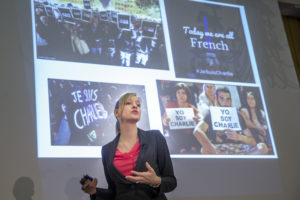Part 3: Countering Terrorist Propaganda in this War of Ideas
 As I mentioned in part one of this blog series, I recently keynoted at NATO’s Public Diplomacy Forum in Brussels. Some of the most interesting things I had the opportunity to learn about during my time at this conference were some particular tactics that terrorist groups, such as ISIS and Al-Qaeda, are using to recruit to their army from around the world.
As I mentioned in part one of this blog series, I recently keynoted at NATO’s Public Diplomacy Forum in Brussels. Some of the most interesting things I had the opportunity to learn about during my time at this conference were some particular tactics that terrorist groups, such as ISIS and Al-Qaeda, are using to recruit to their army from around the world.
I can tell you this: ISIS is petrifyingly brilliant in their communications and recruitment campaigns. Unfortunately, the truth is that they’re astute at communicating and our side has a difficult road ahead of them in order to catch up. Yes, this is frightening. The good news, however, is that there are some amazing NGOs and non-profits out there that are doing some really great things. However, there’s still a lot to be done.
There are a few takeaways and thoughts that have been festering in my mind since my stay in Brussels and I’m going to address them here today. Namely, some of my key observations and thoughts for fighting and winning on the social media front when it comes to propaganda, terrorist recruitment and the likes.
Note: If you haven’t read part one or part two of this series, I recommend reading them before continuing on with this third part.
Why is ISIS propaganda working so well?
From what I’ve seen first-hand, ISIS really gets their target audience. They understand who they’re communicating to in a profound way, which is a big reason why their propaganda and recruitment campaigns are so successful. And although there are counter-extremism groups and organizations that too are good at targeting and communicating, the fact is that I’ve seen a lack of real understanding from many within our side, mainly from within governmental organizations. For example, after watching video recruitment campaigns created by this group, I was asked the following question:
“They have budget, so why was their video so low-quality and badly produced?”
Before I answer this, let me paint you a picture of the particular video that was being referenced…
This video in particular was of a nineteen year old, white Canadian male. He was dressed in his ISIS army wear and was recorded speaking to the camera in a laid-back, conversational tone about his journey and experience. It was a short video, where he talked about how just a few months prior to its recording, he “was like any other regular Canadian,” watching hockey and so on. Now, he’s in Syria fighting on the front lines and loving it (actually, truth be told, now he’s dead). The video ended with this young man calling his viewers to join him, “before the gates close”, before it’s too late.

This video was filmed using a recording device no more complex than a smartphone and was edited using features no more complex than what you will find in iMovie. This video was brilliant. It wasn’t badly produced, it was brilliantly produced. Why? Because, aesthetically speaking, it was exactly the type of video that young people are watching and uploading themselves to youtube. It was therefore relatable.
In the first two parts of this blog series I discussed the importance and impact of emotionally relatable story-telling as both a crisis communications strategy and a risk-management strategy. This is exactly what this video was and did. It related to its target audience by using a relatable archetype and familiar videography, and ended with an enticing and emotionally compelling call to action. It was brilliant and it was, above all, petrifying.
How to counter this type of targeted and strategic narrative
The fact that I was asked why it was so badly produced identified for me a big problem that absolutely needs to be rectified. The problem is a lack of profound understanding of the target audience. The first step in countering propaganda is to understand absolutely everything about who you’re communicating with. This means understanding everything from:
- The technology your target audience uses
- The apps they use
- The way they use this technology, these apps and how they interact online
- Their language, slang and expressions
- How they prefer to consume content
- The types of content they upload and download
- The music they listen to
- Their background and insecurities
… and this is just a short list. The objective is to understand absolutely everything about your target audience. Otherwise, how do you ever expect to reach them on an emotionally compelling level? How do you expect to produce counter-narrative that is just as appealing and enticing as the propaganda you’re countering? Successfully accomplishing this requires a ton of research because the fact is that the generational divide between those creating the counter-narrative and those consuming it is greater than just your difference in age.
Learn from the successes of your opponents
Studying successful propaganda and recruitment campaigns needs to also be a part of your research process. Instead of asking why a video like this is so poorly produced, ask yourself why it worked – especially if you’re surprised by its success. There’s a reason why these types of videos work. What is that reason and how can you use a similar strategy for your communications and counter-narrative?
Once you understand everything about who you’re communicating with and why your opponents’ campaigns and propaganda are working so well, it’s time to put what you learned in part one and part two of this blog series to use.
Put thought into shaping all of your communications as emotionally compelling stories
A panelist at the conference made a comment that, though I understand where he was coming from, I viewed as being another big part of the problem. His comment went something along the lines of this:
We can’t stoop to propaganda and our truth may not be sexy, but we have to keep hammering it out.
Yes, it’s absolutely true that you cannot ever stoop to creating propaganda. Fighting propaganda with propaganda is out of the question. The good guys cannot descend to the level of the bad guys. Doing so would betray trust and discredit credibility, rather than establishing and instilling it. However, you also can’t just continue to hammer out the truth if it’s not successfully reaching the hearts and the minds of those you’re speaking to. The truth may not be sexy, but I don’t necessarily believe that either.
In order to fight and win on the social media front, you have to reach the hearts and then the minds of your stakeholders. This is when persuasion occurs. (tweet this now!)
It was Albert Einstein who said that “insanity is doing the same thing over and over again and expecting different results.” If you’re going to counter propaganda you need to reach the hearts and then the minds of your audiences. In order to do this, you need to shape your messages, your truths, as emotionally relatable stories. (Remember that this is also what will get you the shares that will increase your reach, as we discussed in part one of this series.)
Once you’ve done your homework, you will know how to relate and what appeals to your target audience. Use this information to help you find the story within your message that will allow you to break through the noise and reach them on an emotional level. Remember that logic will never trump emotion. When you touch their hearts, you will have an opportunity to reach their minds. This is when you will succeed.
Recommended read: The Power of Finding New Ways To Communicate The Same Important Message
What about Satire?
 According to Google, “Satire is the use of humor, irony, exaggeration, or ridicule to expose and criticize people’s stupidity or vices, particularly in the context of contemporary politics and other topical issues.” This definition gives me thought, as does the attack on Charlie Hebdo. Here’s why:
According to Google, “Satire is the use of humor, irony, exaggeration, or ridicule to expose and criticize people’s stupidity or vices, particularly in the context of contemporary politics and other topical issues.” This definition gives me thought, as does the attack on Charlie Hebdo. Here’s why:
Humor is an emotion – a powerful emotion at that – and I just made a case above on the power of emotion for countering propaganda.
Interestingly, Huffington Post writer, H. A. Goodman, argues that:
“Satire can destroy the foundations of terrorist recruitment methods since it unmasks the insanity of zealotry. Laughter doesn’t work well when convincing anther human being to strap a bomb and commit suicide. The more people laughing at ISIS, the less it will be able to market itself as the defender of a warped interpretation of Islam.”
Goodman goes on to say:
“When people in the Middle East and around the world laugh at the absurdity that fuels ISIS, this terrorist group’s [raison d’être] will be reduced to a punch line. Ideas can’t be destroyed by weapons and if the ideas that bolster ISIS are mocked with enough satire, “terror” will finally lose its ability to gain followers.” (You can read Goodman’s full article here.)
Now I’m not saying that satire is the answer, but I do think that it can be an answer – one of many that need to be explored, tested and tried. The attack on Charlie Hebdo reinforces this thought. Why else would Al-Qaeda’s branch in Yemen attack and kill cartoonists if they weren’t viewed as a threat?
Not to mention that in places like Egypt, Lebanon and even Iraq and Syria, brave souls are using satire of Islamic extremists to counter the horror that they’re living through and to show that they do not support this extremism. Some of this satire is less provocative and more subtle than that of Charlie Hebdo, but surprisingly not all. If you’re interested in learning more about the satire used by the Islamic community, read this article by Sophia A. McClennen.
Maybe extreme satire is too “sexy” (too risqué) for government agencies, and this I understand. But this is why the privately held organizations dedicated to fighting in this war of ideas is so critical. This is why “Je suis Charlie” is so momentous.
Somewhere to start, though only a start
The fact is that these violent extremist groups are using the power of emotion, relatability and technology to reach their (your) stakeholders and persuade them to their untruths. In order to counter this, to debunk their falsities, you need to position your organization at the forefront and proactively reach the hearts and then the minds of those who are most at risk.
This blog series hopefully inspires thought and action (because it’s all about the proaction), but this series only touches the surface. If you’d like to speak with me about taking this dialogue even further, whether you’re a government agency or a privately held organization, please reach out.

Author of Crisis Ready: Building an Invincible Brand in an Uncertain World, Melissa Agnes is a leading authority on crisis preparedness, reputation management, and brand protection. Agnes is a coveted keynote speaker, commentator, and advisor to some of today’s leading organizations faced with the greatest risks. Learn more about Melissa and her work here.
